Picture this scenario
You’re running a growing company, and every day, you’re confronted with mountains of data—customer feedback, sales figures, inventory metrics, and more. You suspect there’s a treasure trove of insights waiting to be unlocked, but you’re not sure where to begin.
Enter artificial intelligence (AI): the game-changer that promises to transform raw data into actionable strategies, automate routine tasks, and offer personalized experiences to your customers.
Yet, the moment you start digging into the specifics of AI implementation, you’re bombarded with jargon like “AI infrastructure,” “machine learning tech stack,” and “AI-driven digital transformation.”
If this sounds familiar, you’re in the right place. Welcome to our in-depth guide on building an AI Tech Stack for businesses—a blueprint that demystifies how to get your company up to speed with the latest AI innovations.
This isn’t a tech tutorial filled with complicated code snippets or vague promises.
Instead, we’ll walk you step by step through the essential layers of an AI technology stack—from data pipelines and model development to deployment and scalability—so you can make informed decisions that directly impact your bottom line.
Whether you’re a small startup searching for cost-effective AI solutions or an established enterprise aiming to maintain a competitive edge through AI-powered business solutions, understanding the AI tech stack is your ticket to success.
Think of it as the operating system for your AI journey: get it right, and you’ll be able to unlock new levels of productivity, customer satisfaction, and innovation.
Over the next few sections, we’ll break down the basics, explore different AI stack types (like cloud-based, on-premise, and hybrid), and answer common questions about AI adoption in business.
By the end, you’ll be equipped with the knowledge you need to start—or refine—your organization’s AI-driven digital transformation. Ready to discover what AI can really do for your business?
Let’s dive in.
What is an AI tech stack (and why should you care)?
At its core, an AI Tech Stack is the collection of tools, technologies, and methodologies that enable businesses to develop, deploy, and maintain AI-driven solutions.
Think of it like the engine under the hood of your car. The better the components work together, the smoother your ride—and the more you can accomplish without worrying about technical hiccups.
For business owners, the term “AI tech stack” might sound intimidating or overly technical.
Rest assured: You don’t need a PhD in computer science to appreciate its value. If your company handles data (spoiler alert: it does!), then you already have the building blocks for machine learning and other AI-powered business solutions.
The AI tech stack is simply the framework that helps you organize these building blocks, ensuring they run efficiently and effectively.
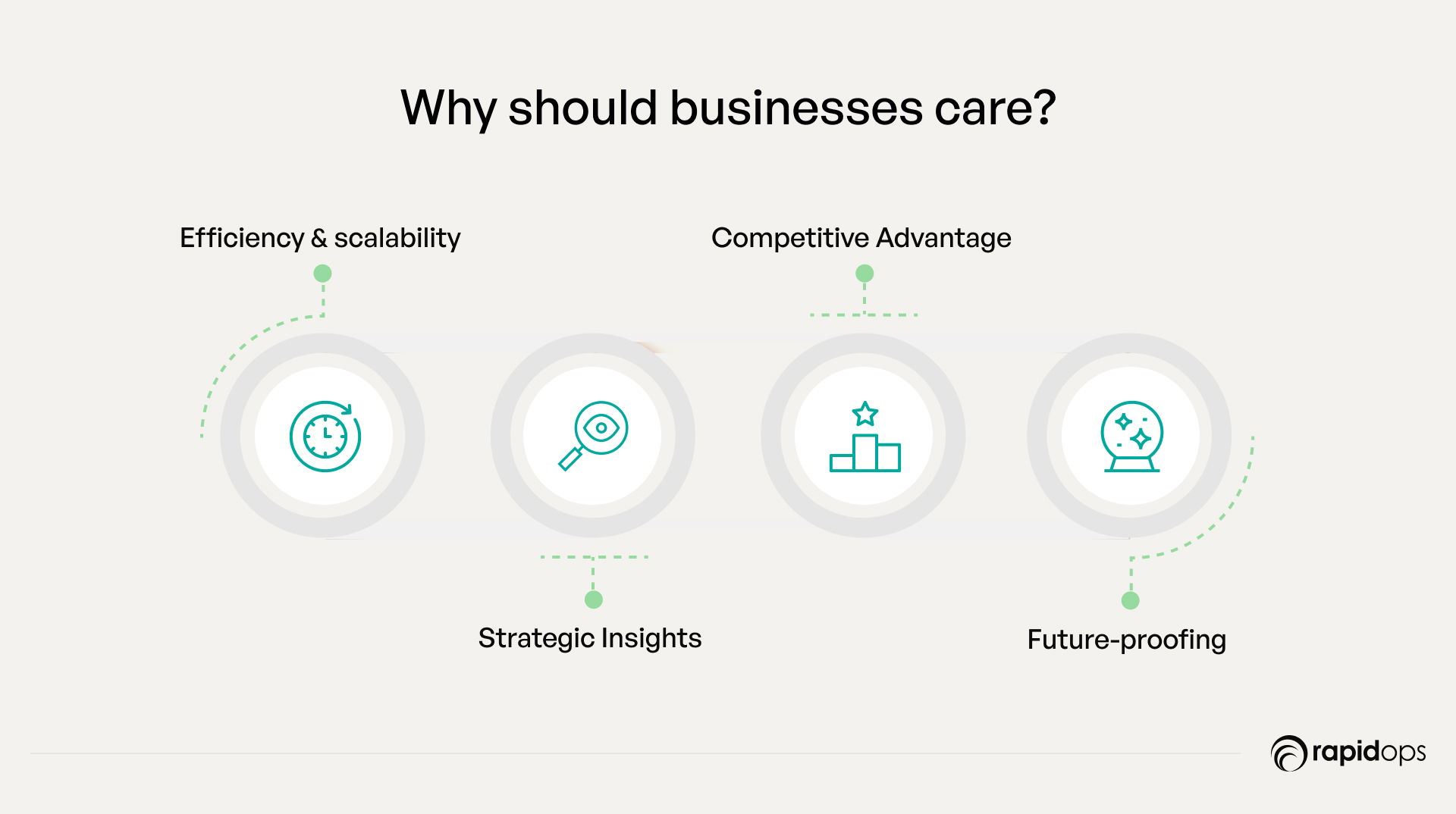
Why should businesses care?
1. Efficiency and scalability
By having a well-structured AI Tech Stack, you streamline workflows—making it easier to analyze data, build predictive models, and integrate them into your everyday operations. As you grow, scaling your AI infrastructure becomes more manageable.
2. Strategic insights
With a robust AI technology stack, you can glean actionable insights from massive data sets. Whether it’s customer behavior, market trends, or inventory optimization, AI can turn raw numbers into informed, strategic decisions.
3. Competitive advantage
In an era where digital transformation sets companies apart, leveraging AI-powered business solutions is critical. An effective AI Tech Stack ensures you stay ahead of market shifts, meet customer demands faster, and innovate continuously.
4. Future-proofing
AI is not just a fad. As technology evolves, businesses with a solid machine learning tech stack will more easily adopt new innovations—be it edge computing, natural language processing, or industry-specific AI solutions—keeping them relevant in a rapidly changing landscape.
Investing in an AI Tech Stack is about leveraging technology to drive measurable business outcomes—improved customer experiences, reduced operational costs, and better decision-making.
In the next sections, we’ll break down the key components of an AI Tech Stack and explore how each layer contributes to your organization’s success.
The components of an AI tech stack
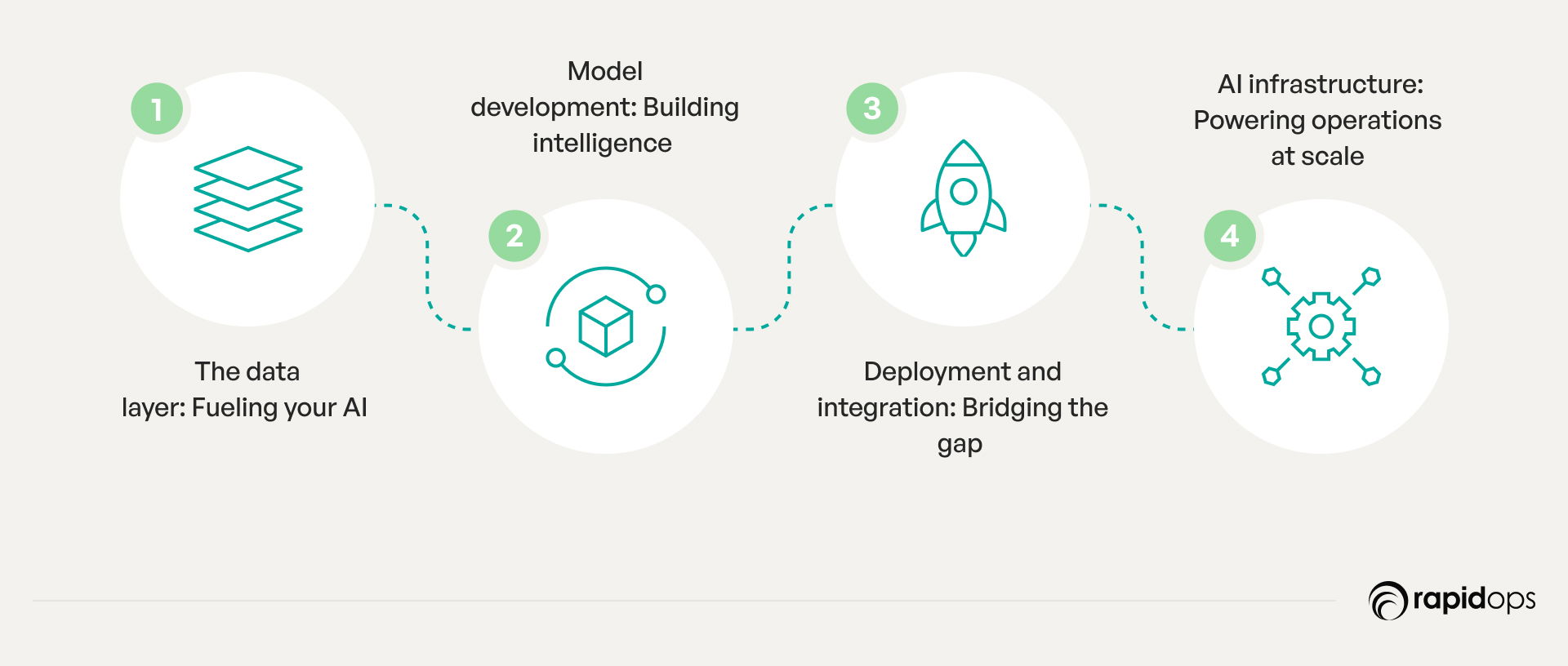
Now that we’ve defined what an AI tech stack is and why it matters, let’s look under the hood and explore the components that bring AI-driven solutions to life.
Think of each piece—data, models, deployment, and infrastructure—like gears in a well-tuned machine. When they work together seamlessly, your AI-powered business solutions run efficiently and deliver tangible value.
1. The data layer: Fueling your AI
Data is the beating heart of every machine learning initiative. Without high-quality, relevant data, even the most advanced models struggle to deliver meaningful insights.
Here’s what typically goes into the data layer:
-
Data collection and preparation: Gathering information from multiple sources—CRM systems, website analytics, social media, and more—then cleaning and organizing it for analysis.
-
Data storage solutions: Depending on your needs, this could be cloud-based (like AWS or Azure) or on-premise databases.
-
Business intelligence pipelines: Tools and workflows designed to move data efficiently from storage to your AI models, ensuring quick access to the most up-to-date information.
2. Model development: Building intelligence
Once your data is ready, the next step is creating and refining the algorithms that make AI “smart.”
This stage usually includes:
-
AI model development platforms: Popular choices like TensorFlow and PyTorch help data scientists and developers craft sophisticated machine learning models.
-
Open-source vs. proprietary frameworks: Choosing between free, community-driven tools or paid, enterprise-grade solutions depends on factors like budget, security needs, and the complexity of your projects.
-
Experimentation and optimization: Through techniques like hyperparameter tuning and cross-validation, your team refines models to ensure they perform accurately in real-world scenarios.
3. Deployment and integration: Bridging the gap
Having a well-trained AI model is just half the battle.
You also need to incorporate it into your business processes:
-
AI deployment frameworks: Decide between deploying your models on-premise (for tighter control and security) or in the cloud (for easier scalability). Some businesses even adopt a hybrid approach.
-
APIs and SaaS tools: Seamlessly plug AI capabilities into existing systems, like CRM platforms or e-commerce sites, to ensure minimal disruption and maximum impact.
-
Lifecycle management: Over time, models may drift from their initial performance targets. Routine monitoring and updates are crucial to maintain high accuracy levels.
4. AI infrastructure: powering operations at scale
The final component underpins everything else, ensuring your AI solutions run smoothly:
-
Cloud computing: Providers like AWS, Google Cloud, and Azure offer managed services for machine learning, which can simplify scaling and reduce hardware investments.
-
Computing power (GPUs and CPUs): High-performance hardware accelerates training and inference for large models, crucial for tasks like deep learning.
-
Security and compliance: From encryption protocols to data governance frameworks, robust infrastructure helps businesses meet regulatory demands and safeguard sensitive information.
By assembling these components thoughtfully, you create a cohesive AI tech stack that fits your organization’s goals.
In the next section, we’ll delve deeper into the different types of AI tech stacks, so you can decide which configuration makes the most sense for your business context and growth plans.
Types of AI tech stacks
Not all businesses have the same goals, budget constraints, or security requirements. As a result, there’s no one-size-fits-all approach to AI infrastructure.
Below, we’ll explore four main categories of AI tech stacks—each offering distinct advantages and considerations for organizations looking to integrate AI-driven solutions.
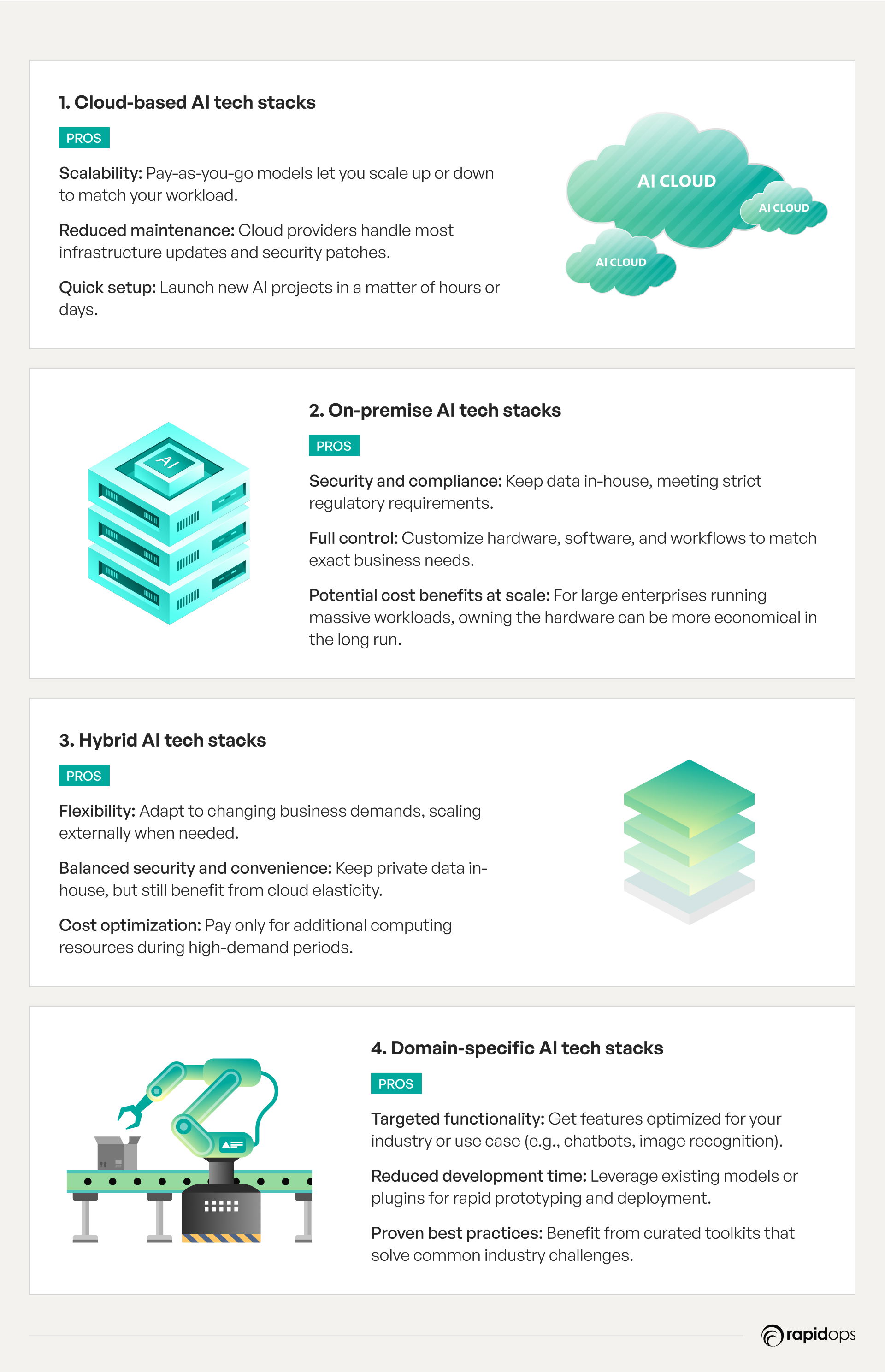
1. Cloud-based AI tech stacks
If convenience and scalability are top priorities, a cloud-based AI tech stack may be your best bet. Here, you leverage the computing resources of third-party providers like Amazon Web Services (AWS), Microsoft Azure, or Google Cloud. You can quickly provision machine learning tools, data storage, and AI model deployment environments without large upfront investments in hardware.
-
Pros:
-
-
Scalability: Pay-as-you-go models let you scale up or down to match your workload.
-
-
-
Reduced maintenance: Cloud providers handle most infrastructure updates and security patches.
-
-
-
Quick setup: Launch new AI projects in a matter of hours or days.
-
-
Cons:
-
-
Ongoing costs: Monthly or usage-based fees can add up, especially for data-intensive tasks.
-
-
-
Limited control: You rely on external vendors to manage underlying hardware and some security measures.
-
2. On-premise AI tech stacks
For organizations handling sensitive information—such as healthcare providers, financial institutions, or government agencies—an on-premise AI tech stack may offer greater control and compliance. Here, you build and maintain your own AI infrastructure, from data centers to specialized hardware like GPUs.
-
Pros:
-
-
Security and compliance: Keep data in-house, meeting strict regulatory requirements.
-
-
-
Full control: Customize hardware, software, and workflows to match exact business needs.
-
-
-
Potential cost benefits at scale: For large enterprises running massive workloads, owning the hardware can be more economical in the long run.
-
-
Cons:
-
-
High upfront costs: Procuring servers, GPUs, and other infrastructure can be expensive initially.
-
-
-
Maintenance overhead: Your IT team must handle everything from hardware failures to software updates.
-
3. Hybrid AI tech stacks
Sometimes, the most effective strategy is a combination of both cloud-based and on-premise solutions, known as a hybrid AI tech stack. You might store certain sensitive datasets and models on-premise for compliance purposes, while offloading less-critical workloads or peak-time compute jobs to the cloud.
-
Pros:
-
-
Flexibility: Adapt to changing business demands, scaling externally when needed.
-
-
-
Balanced security and convenience: Keep private data in-house, but still benefit from cloud elasticity.
-
-
-
Cost optimization: Pay only for additional computing resources during high-demand periods.
-
-
Cons:
-
-
Complex setup: Managing workflows that span both private data centers and the cloud requires advanced planning and coordination.
-
-
-
Integration challenges: Ensuring seamless data flow and consistent performance can be tricky.
-
4. Domain-specific AI tech stacks
In some cases, businesses may opt for domain-specific AI tech stacks tailored to particular applications—like natural language processing, computer vision, or robotic process automation. These specialized ecosystems often include pre-trained models, ready-made frameworks, or industry-specific tools, enabling faster development of AI-powered business solutions.
-
Pros:
-
-
Targeted functionality: Get features optimized for your industry or use case (e.g., chatbots, image recognition).
-
-
-
Reduced development time: Leverage existing models or plugins for rapid prototyping and deployment.
-
-
-
Proven best practices: Benefit from curated toolkits that solve common industry challenges.
-
-
Cons:
-
-
Niche expertise: Might require specialized talent to fine-tune or maintain these specific tools.
-
-
-
Less flexibility: Adapting domain-specific stacks to broader applications can be cumbersome.
-
By exploring these AI tech stack types, you can align your choice with your company’s unique goals, regulatory needs, and budget constraints.
In the next section, we’ll examine how different organizations—from lean startups to large enterprises—can build an AI tech stack that suits their scale and operational priorities.
How to build an AI tech stack for different business sizes
Building an AI tech stack can feel like a daunting project, especially when you’re juggling budget constraints, resource limitations, and unique business goals.
However, whether you’re running a scrappy startup or a large enterprise, having a structured approach will guide you toward a successful AI-driven digital transformation.
Below, we break down strategies for different business sizes, ensuring you get the most out of your AI infrastructure investments.
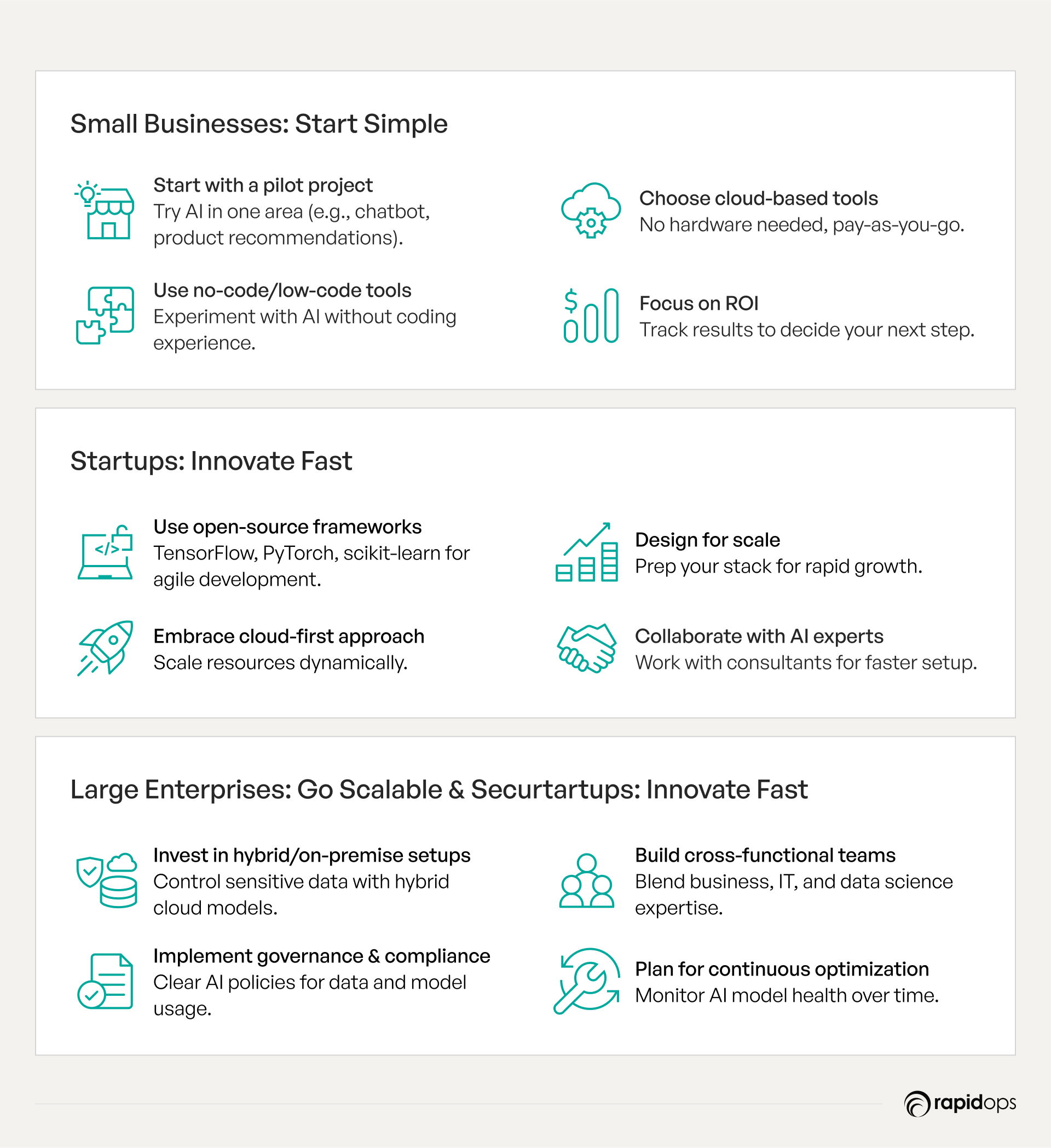
1. For small businesses: Keep it lean and focused
If you’re a small business looking to dip your toes into AI without a massive upfront commitment, simplicity is your best friend.
-
Start with a pilot project: Identify one area where AI-powered solutions could make an immediate impact. This could be something like a recommendation system for your online store or an automated chatbot for customer service.
-
Leverage low-code or no-code platforms: Many AI model development tools now offer user-friendly interfaces that don’t require deep technical expertise. This is a cost-effective way to experiment with machine learning and see quick wins.
-
Opt for cloud-based tools: A cloud-based AI tech stack lets you skip costly hardware investments. Pay-as-you-go models keep budgets predictable while still providing the flexibility to scale when your needs grow.
-
Focus on ROI: Measure the results of your pilot project. If your first AI venture shows promise (like reduced response times or increased sales), it’s easier to justify additional investments.
2. For startups: Innovate fast and validate quickly
For startups, speed to market and innovation are critical. You’re often operating under tight timelines and must prove traction to stakeholders or investors.
-
Adopt open-source frameworks: Tools like TensorFlow, PyTorch, and scikit-learn can give you a robust machine learning tech stack without licensing fees. This allows you to channel resources into model optimization and product-market fit.
-
Cloud-first approach: Similar to small businesses, a cloud-based AI infrastructure can accelerate your development cycles. It lets you provision resources on-demand and pivot if you need to change direction.
-
Design for scaling: Startups that succeed often grow rapidly. Build your AI architecture with scalability in mind—from data pipelines to model deployment—so you won’t face huge roadblocks when user demand spikes.
-
Collaborate with experts: If you lack in-house AI skills, consider partnering with AI consultants or specialized agencies. This can help you build a cost-effective AI tech stack quickly, without the overhead of maintaining a large technical team.
3. For large enterprises: Aim for robust, scalable solutions
Enterprises generally have more resources but also face complex requirements around data security, governance, and regulatory compliance. Here’s how to align your AI development stack with your strategic objectives:
-
Invest in hybrid or on-premise solutions: If your organization deals with sensitive information (finance, healthcare, government), a hybrid AI tech stack or an on-premise setup can offer better data control while still leveraging cloud elasticity when needed.
-
Implement governance and compliance frameworks: Large-scale AI-driven solutions require clear protocols for data usage, privacy, and model maintenance. Establish a robust AI governance policy to guide your teams.
-
Build cross-functional teams: Create synergy between data scientists, IT, and business leaders to ensure the AI software stack aligns with both technical needs and corporate goals. Regular communication prevents siloed efforts.
-
Plan for continuous optimization: AI model lifecycle management is crucial. Models can “drift” over time as data evolves, so scheduling updates, audits, and performance checks keeps your solutions accurate and trustworthy.
By tailoring your AI tech stack strategy to your organization’s size, budget, and growth stage, you set yourself up for meaningful results—whether it’s improved customer satisfaction, streamlined operations, or new revenue streams.
In the following section, we’ll explore how to choose the right stack for your unique business context, using real-world scenarios to illustrate each option’s pros and cons.
Choosing the right AI tech stack for your business
With so many AI tech stack options available—ranging from cloud-based to on-premise or even specialized domain-specific solutions—how do you decide which is best for your organization?
The answer lies in balancing business needs, technical constraints, and future ambitions.
Below, we’ll walk through some practical considerations to guide you toward the stack that best aligns with your goals.
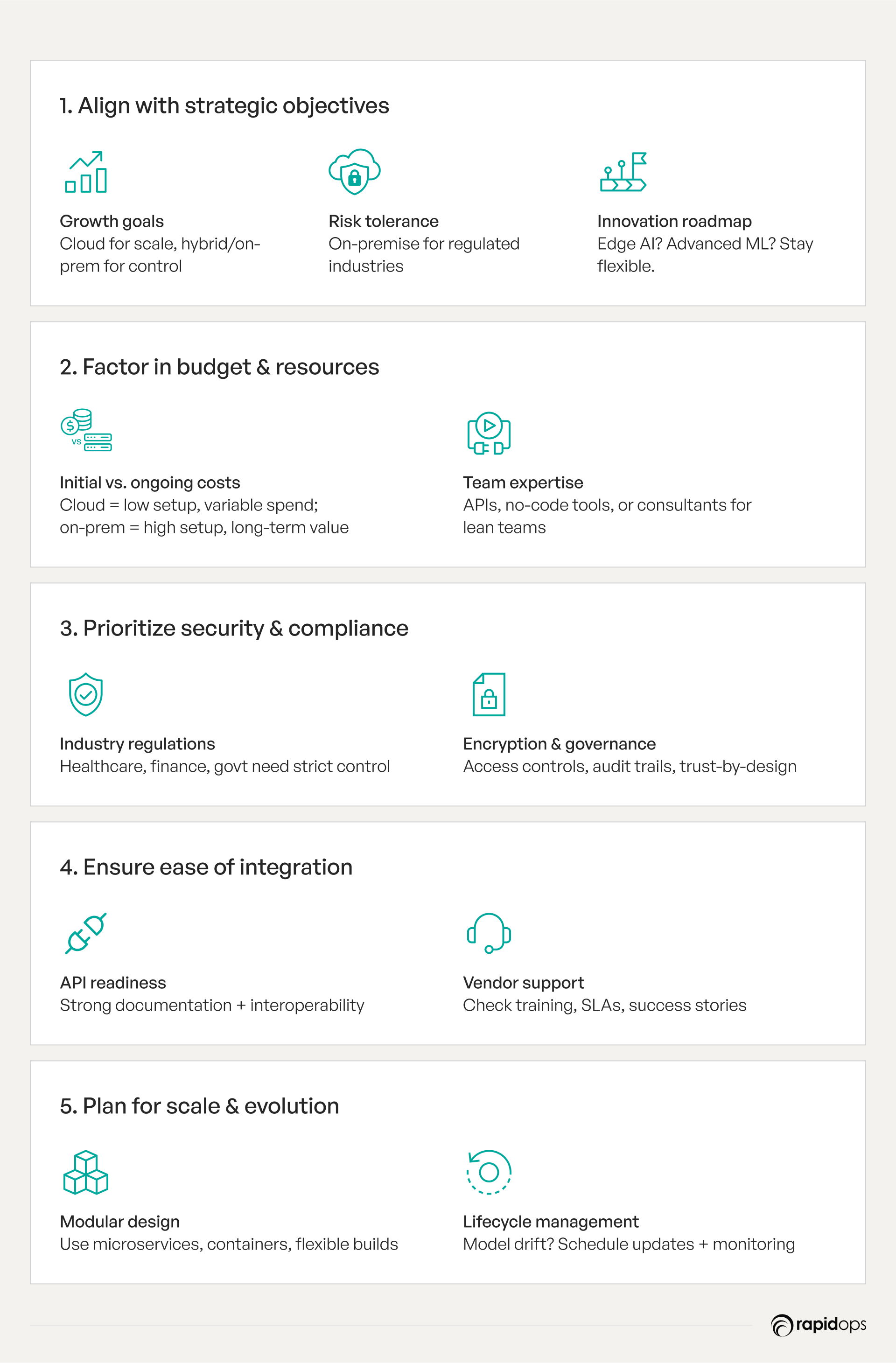
1. Align with your strategic objectives
Before diving into specific technologies, take a step back and assess your company’s overarching vision:
-
Growth goals: Are you looking to scale quickly or serve a niche market? High-growth startups might prioritize cloud-based AI infrastructure for rapid deployment, while more established companies may consider on-premise or hybrid solutions for tighter control and compliance.
-
Risk tolerance: If you operate in a heavily regulated industry, mitigating risks around data security and privacy will be paramount—an on-premise or hybrid AI tech stack can address these concerns.
-
Innovation roadmap: Do you plan to explore emerging technologies like edge AI or advanced machine learning techniques? Choosing flexible tools and frameworks can make it easier to pivot as new opportunities arise.
2. Factor in budget and resource availability
Money and manpower play a big role in shaping your AI development stack:
-
Initial investment vs. ongoing costs: A cloud-based AI tech stack often has lower upfront costs but may lead to higher monthly expenses based on usage. By contrast, on-premise setups typically require substantial initial capital for hardware and staffing but can be more cost-effective over the long haul for large workloads.
-
Team expertise: If your in-house talent is limited, you might lean on managed services or AI consultancies to help set up and maintain your stack. Smaller teams often find AI APIs and low-code platforms beneficial for quick wins without heavy technical debt.
3. Assess data security and compliance needs
Data is the lifeblood of AI-driven solutions, so keeping it secure is non-negotiable:
-
Regulatory requirements: If you’re in healthcare, finance, or government sectors, strict laws often dictate how data must be stored and processed. An on-premise AI tech stack or a hybrid model may provide the right level of control.
-
Encryption and governance: Ensure that whichever AI architecture you pick supports robust encryption standards, user access controls, and auditing capabilities to maintain compliance and trust.
4. Look for ease of integration
Most businesses already have existing workflows, from CRM systems to ERP solutions. A smooth AI deployment depends on how easily new tools can integrate with current systems:
-
API readiness: Look for platforms or frameworks that offer clear documentation and robust API support, making it simpler to connect AI-powered business solutions with your day-to-day operations.
-
Vendor support: If you’re leaning on a specific vendor for hosting or specialized tools, check for customer success stories, training options, and response times for technical support.
5. Plan for scalability and evolution
A good AI tech stack isn’t just about solving today’s problems—it should also accommodate tomorrow’s growth:
-
Modular design: Whether you’re using microservices or containerization, modularity allows your AI infrastructure to adapt without massive overhauls.
-
Regular reviews and updates: AI models can degrade over time if they aren’t retrained or updated with new data. Make sure your approach includes lifecycle management, performance monitoring, and periodic refreshes.
By weighing these factors—strategic objectives, budget, compliance, integration, and scalability—you can pinpoint an AI tech stack that aligns with your unique business context.
In the next section, we’ll look at some future trends in AI tech stacks, ensuring you’re well-prepared for the innovations and market changes just around the corner.
Future trends in AI tech stacks
As artificial intelligence continues to evolve, so does the ecosystem supporting it.
Businesses that stay informed about emerging trends will be better positioned to adapt and leverage new opportunities.
Below are some of the most noteworthy developments shaping AI tech stacks today and in the near future.
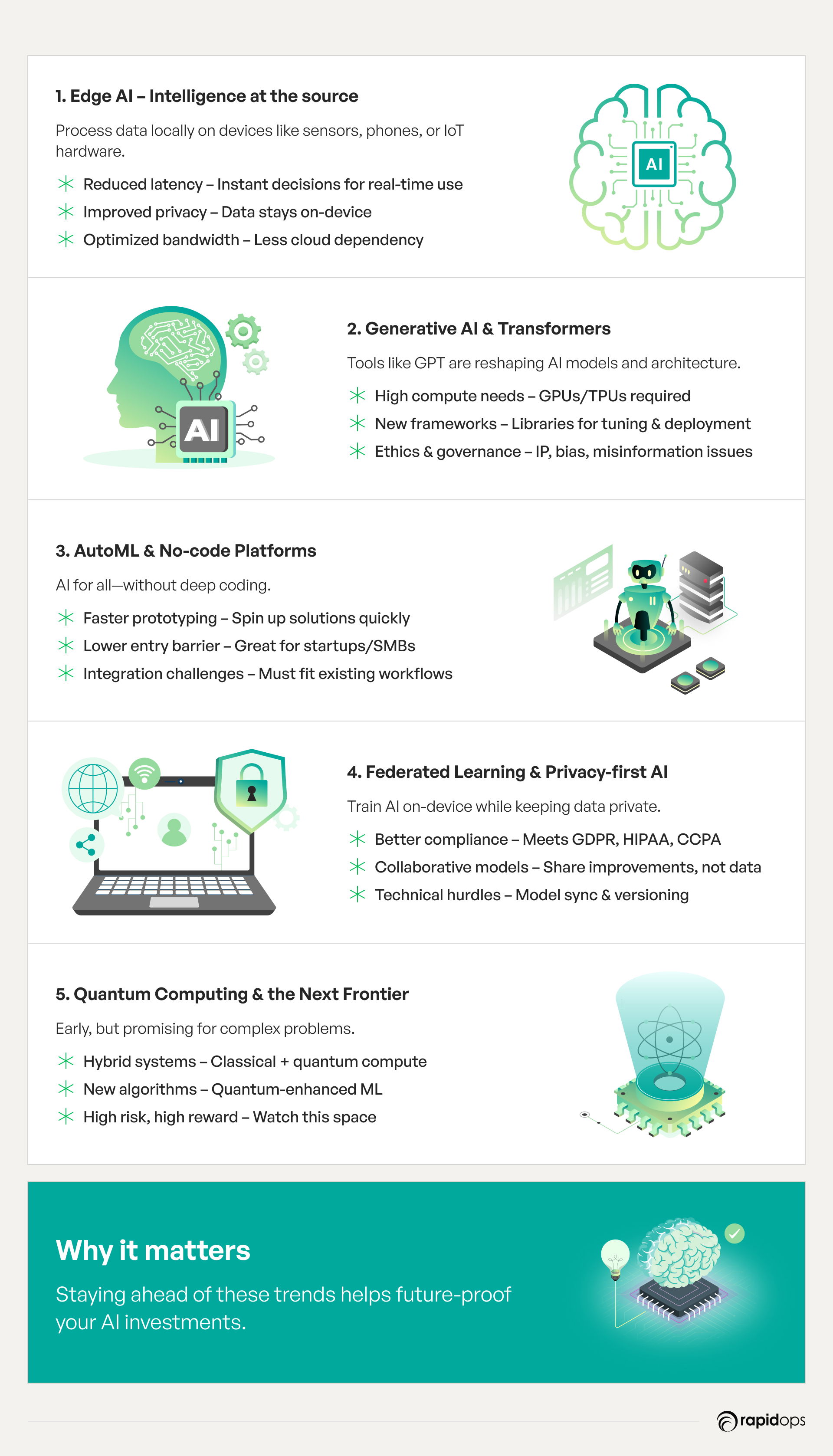
1. Edge AI: Moving intelligence closer to the source
Traditionally, AI-powered solutions rely on centralized cloud servers for processing data. However, with edge AI, data is processed locally on devices such as sensors, smartphones, or IoT (Internet of Things) hardware. This shift brings several advantages:
-
Reduced latency: Real-time applications (like autonomous vehicles or smart manufacturing systems) can’t afford delays caused by sending data to the cloud and back.
-
Improved privacy: Sensitive data stays on the device, minimizing exposure risks.
-
Optimized bandwidth: Less data traveling across networks leads to cost savings and faster responses.
As devices become more powerful, edge computing will continue to grow, shaping AI infrastructure designs that balance local processing with cloud-based analytics.
2. Generative AI and Transformer models
Models like GPT (Generative Pre-trained Transformer) have taken the world by storm, enabling capabilities such as automated content creation, advanced language understanding, and sophisticated machine learning applications.
These large-scale models often require specialized hardware (like GPUs or TPUs) and can influence how businesses structure their AI tech stack:
-
Increased computational demands: Training and running generative models can be resource-intensive, impacting decisions around on-premise vs. cloud-based AI setups.
-
Specialized tooling: New frameworks and libraries are emerging to make it easier to fine-tune and deploy generative models, pushing businesses to rethink model development pipelines.
-
Ethical considerations: Generative AI amplifies concerns around misinformation, biases, and intellectual property, prompting more robust AI governance and policy discussions.
3. AutoML and low-code/no-code platforms
Another significant trend is the rise of AutoML (Automated Machine Learning) and low-code/no-code solutions, which aim to democratize AI development. These tools allow non-technical users to build and deploy AI models with minimal coding:
-
Faster prototyping: Businesses can quickly spin up AI-driven solutions for tasks like predictive analytics or customer segmentation without deep technical expertise.
-
Lower entry barriers: Smaller organizations and startups can tap into AI tech stacks without hiring large teams of data scientists.
-
Integration challenges: As these tools become mainstream, ensuring they fit seamlessly within existing AI architectures remains a priority for technology leaders.
4. Federated learning and privacy-centric AI
In an era of tightening data regulations (GDPR, CCPA, HIPAA), privacy-centric AI approaches are gaining traction. Federated learning is one such method, enabling AI models to train on decentralized data without that data ever leaving individual devices or servers:
-
Better compliance: Highly regulated industries can implement machine learning without centralized data pools, reducing breach risks.
-
Collaborative models: Multiple entities can benefit from shared model improvements without exposing raw data to one another.
-
Technical complexity: Federated learning introduces unique challenges in synchronization, versioning, and AI model lifecycle management.
5. Quantum computing and beyond
Though still in early stages, quantum computing holds potential to revolutionize how we solve certain types of problems, such as complex optimizations or simulating molecular structures. While practical quantum AI is likely years away for everyday business use, forward-thinking organizations keep an eye on these developments:
-
Hybrid quantum-classical solutions: Early quantum machines work alongside classical computing to tackle specialized tasks, hinting at future AI infrastructure designs.
-
Emerging algorithms: Researchers are exploring quantum-enhanced machine learning methods that could break current performance barriers.
-
Risk and reward: Adopting quantum-related tech carries uncertainty, but it also offers the potential for breakthrough innovations.
Staying current with these trends helps businesses future-proof their AI tech stack.
By proactively adopting or at least preparing for new methodologies—such as edge AI, generative models, or federated learning—you can keep pace with industry shifts and ensure your AI-powered business solutions remain competitive and compliant.
Conclusion and call to action
Building the right AI tech stack isn’t just about picking the latest tools or hopping on technology trends; it’s about making strategic decisions that align with your organization’s unique goals, constraints, and ambitions.
From data pipelines and machine learning models to AI infrastructure options and emerging solutions like edge AI or federated learning, each element plays a critical role in delivering real business value.
By now, you’ve seen how different AI tech stack types—cloud-based, on-premise, hybrid, or domain-specific—can serve businesses of all shapes and sizes. Whether you’re a small startup leveraging open-source platforms to move fast, or a large enterprise focusing on compliance and scalability, the key is to tailor an approach that allows you to innovate, adapt, and grow sustainably.
In a world where digital transformation can spell the difference between market leaders and laggards, a well-structured AI tech stack gives you the competitive edge to automate tasks, extract powerful insights, and craft AI-powered business solutions that delight your customers. But remember: technology alone isn’t the endgame. True success lies in uniting strategy, people, and processes around a clear AI vision.
Ready to transform your business with AI?
Imagine your business seamlessly automating mundane tasks, predicting customer behaviors with pinpoint accuracy, and discovering untapped revenue streams—all powered by AI.
At Rapidops Inc., we’ve guided organizations from data-burdened to data-driven, unlocking the full potential of AI tech stacks tailored to their unique goals.
Ready to make your data work smarter? Schedule a cost-free consultation call with our AI and data specialists, and let’s chart a customized roadmap that transforms your operations and positions you for growth. The next big AI success story could be yours—let’s start building it together!

Saptarshi Das
Content Editor
9+ years of expertise in content marketing, SEO, and SERP research. Creates informative, engaging content to achieve marketing goals. Empathetic approach and deep understanding of target audience needs. Expert in SEO optimization for maximum visibility. Your ideal content marketing strategist.

Let’s build the next big thing!
Share your ideas and vision with us to explore your digital opportunities
Similar Stories
- AI
- 4 Mins
- September 2022

- AI
- 9 Mins
- January 2023


Receive articles like this in your mailbox
Sign up to get weekly insights & inspiration in your inbox.

